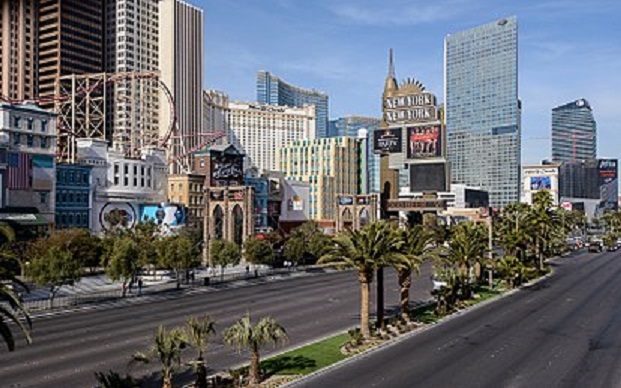Atlanta,
GA –– After suffering the greatest performance declines in the history of
the U.S. lodging industry during 2020, the nation’s hotels will benefit from
what is expected to be a relatively rapid economic turnaround in 2021 and 2022,
according to the June 2020 edition of CBRE’s
Hotel Horizons forecast report.
 |
| Jamie Lane |
CBRE foresees demand for U.S. lodging accommodations
returning to precrisis levels in the third quarter of 2022. However, a lag in
ADR (average daily rate) growth will stall the recovery in RevPAR (revenue per
available room) until 2023.
“The
U.S. lodging sector has been hit by two headwinds in 2020: a contraction in
overall economic activity and the need for social distancing,” said Jamie Lane,
Senior Director of CBRE Hotels Research.
“Accordingly,
our current forecast calls for a 37 percent reduction in the number of room
nights occupied in 2020 compared to 2019. There is some comfort knowing that
travelers will be back on the road in full force within two years.”
U.S.
hotel occupancy levels are projected by CBRE to decline as low as 26.2 percent
during the second quarter of 2020.
 |
| Bram Gallagher |
CBRE
forecasts an annual occupancy level of 41.0 percent for 2020, and that luxury
hotels will experience the lowest 2020 annual occupancy, at 33.4 percent.
Conversely,
economy hotels are projected to achieve the highest annual occupancy level, at
46.4 percent.
Consistent
with prior recessions, the severe declines in demand have sapped pricing. Based
on data from STR, the national ADR level in April 2020 dropped 44 percent
compared to April 2019.
“The
decline in occupancy only partially explains the weak ADR,” Mr. Lane said.
“Low
occupancy levels and closures within the upper-priced segments will result in a
disproportionate percentage of total U.S. demand accommodated at the
lower-priced segments in 2020.
"Conversely,
in 2021, most of the new demand will be accommodated at reopened upper-priced
properties at higher room rates. This skews the ADR growth rate upward.”
The
significant decrease in occupancy, combined with a forecast 22.5 percent drop
in ADR for the year, results in a projected decline in RevPAR of 51.9 percent
in 2020.
Looking forward, CBRE sees U.S. RevPAR surpassing its 2019 level in 2023 fueled by the rise in demand and occupancy. ADR, on the other hand, will lag in its recovery until 2024.
Looking forward, CBRE sees U.S. RevPAR surpassing its 2019 level in 2023 fueled by the rise in demand and occupancy. ADR, on the other hand, will lag in its recovery until 2024.
The
Turnaround
Based
on CBRE’s forecast, the pace of declining occupancy, ADR, RevPAR and demand is
expected to begin lessening during the third quarter of 2020. Year-over-year
growth in each measure is anticipated by the second quarter of 2021.
“Although
the trough in 2020 lodging performance will be much deeper than anything we’ve
seen in the past 80 years, much of this decline is not caused by underlying
fundamental economic problems,“ said Bram
Gallagher, Senior Economist with CBRE Hotels Research.
“Once social gathering restrictions are
lifted, an expected return to the strong underlying economic conditions that
existed before 2020 will restore economic production.”
A critical factor driving the lodging recovery is a
reduction in the number of new COVID-19 cases.
In the event of a prolonged need for social
distancing and a persistent occurrence of new COVID-19 cases, CBRE has
developed a forecast of a hypothetical downside scenario in which the recovery
in RevPAR to precrisis levels is pushed out to 2025.
“Drive-to leisure destinations have been the first markets to show signs of recovery,” Mr. Lane said.
“Drive-to leisure destinations have been the first markets to show signs of recovery,” Mr. Lane said.
“When people can drive in their own car, and
then go directly into their own room, they have a sense of control and safety.
"Hotels
oriented toward group meetings will likely lag in recovery as meeting attendees
get reacclimated to being close to large numbers of people.”
While
the demand for U.S. lodging is forecasted to return to precrisis levels in the
third quarter of 2022, the national ADR is not expected to recover on a nominal
basis until the third quarter of 2023.
However, even by 2023, less than half of the
60 markets in CBRE’s Hotel Horizons universe are expected to have achieved an
ADR recovery.
“The resiliency of owners and operators will be tested
this year, and government and financial assistance will be required,” Mr. Lane
said. “However, I believe the industry will be pleased with the pace of
the recovery when we perform our retrospective analysis in the years to come.”
The
June 2020 edition of Hotel Horizons® for the U.S.
lodging industry and 60 major markets can be purchased by visiting: https://pip.cbrehotels.com.
To view
CBRE Hotels’ latest analysis of the impact of COVID-19 on the lodging industry,
please visit:
About CBRE Group, Inc.
CBRE
Group, Inc. (NYSE:CBRE), a Fortune 500 and S&P 500 company headquartered in
Los Angeles, is the world’s largest commercial real estate services and
investment firm (based on 2019 revenue).
The
company has more than 100,000 employees (excluding affiliates) and serves real
estate investors and occupiers through more than 530 offices (excluding
affiliates) worldwide.
CBRE
offers a broad range of integrated services, including facilities, transaction
and project management; property management; investment management; appraisal
and valuation; property leasing; strategic consulting; property sales; mortgage
services and development services.
Please
visit our website at www.cbre.com.
Media
Contact:
Chris
Daly
Daly
Gray Public Relations
703
435 6293









No comments:
Post a Comment